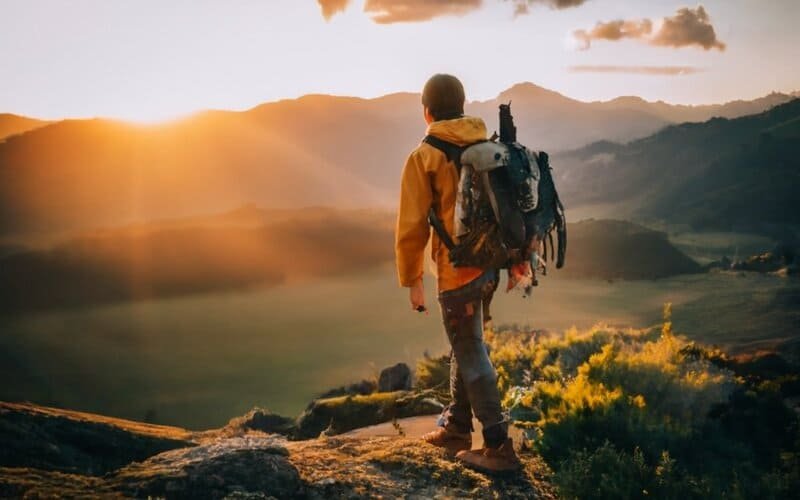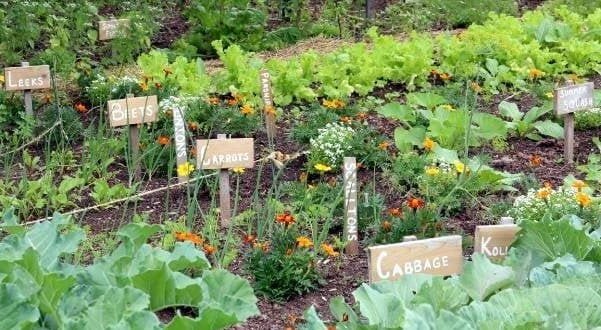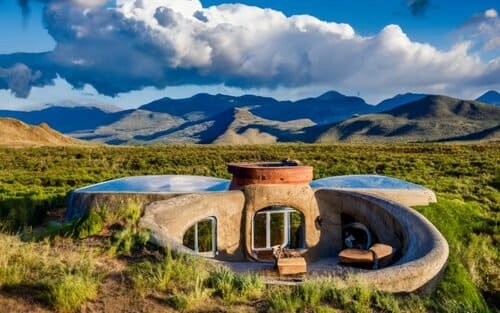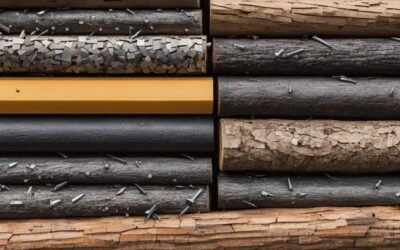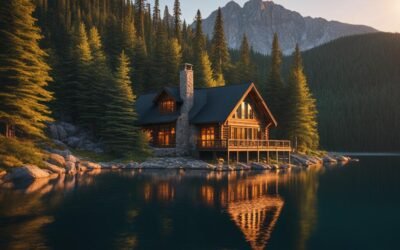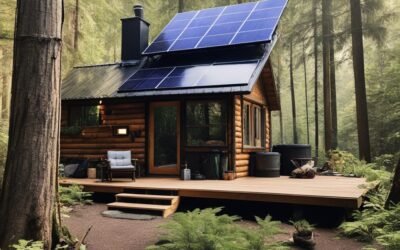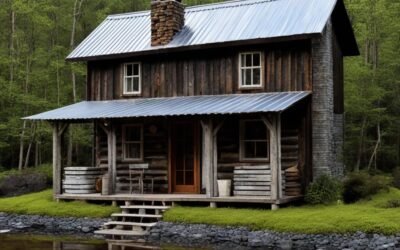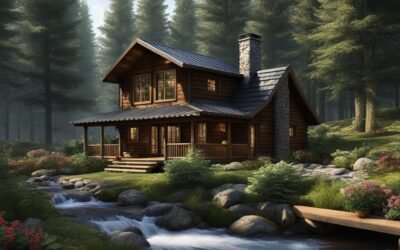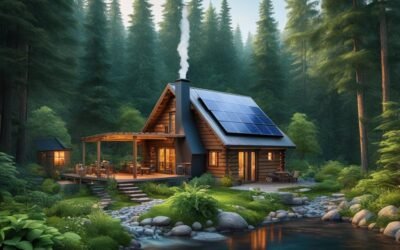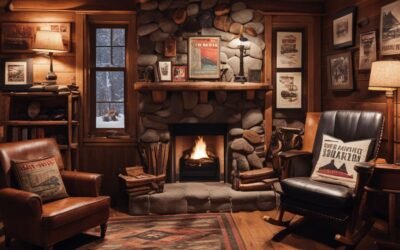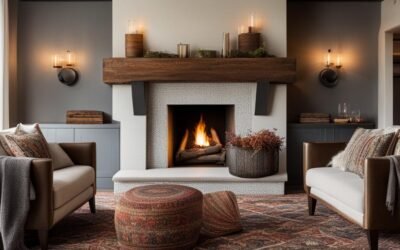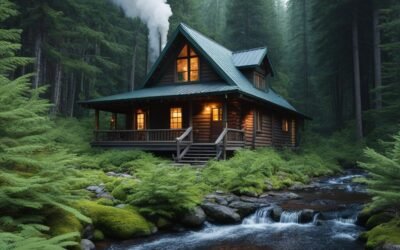Are you looking for a unique and eco-friendly way to disconnect from the stress of everyday life? Look no further than off grid cabins. These sustainable and self-sufficient retreats offer a peaceful escape in nature while minimizing your impact on the environment.
Whether you dream of a secluded cabin deep in the woods or a desert oasis surrounded by cactus, off grid cabins provide the perfect opportunity to embrace off grid living and immerse yourself in the beauty of your surroundings. These cabins are designed to be small, affordable, and accessible, making them suitable for anyone seeking an off grid getaway.
From utilizing solar power for energy to rainwater collection for water use, off grid cabins incorporate a variety of sustainable features. Composting toilets minimize waste, while energy-efficient materials and designs further enhance their environmental friendliness. These cabins demonstrate that eco-friendly living can go hand in hand with modern comforts.
Off grid cabins also showcase unique materials and construction methods. Some cabins are made entirely out of repurposed timber, giving new life to old materials. Others utilize eco-friendly materials like hemp insulation and locally sourced wood. These innovative approaches prove that sustainable housing can be both beautiful and functional.
Picture yourself waking up to the sounds of birds chirping or watching a breathtaking sunset from your off grid cabin. These retreats offer an escape from the fast-paced world, allowing you to reconnect with nature and find peace in the serenity of remote locations.
Key Takeaways:
- Off grid cabins provide an eco-friendly way to retreat from the modern world.
- These cabins offer self-sufficiency and sustainable features such as solar power and composting toilets.
- Unique materials and construction methods make off grid cabins both functional and environmentally friendly.
- Off grid living allows you to immerse yourself in the beauty of different landscapes.
- Off grid cabins provide a peaceful and tranquil escape from the noise and busyness of everyday life.
Unique Designs and Locations
Off grid cabins offer a wide range of unique designs and can be found in diverse locations, providing the perfect blend of a cabin retreat with energy independence and rural accommodations for those seeking a green living experience. These cabins showcase the endless possibilities of off grid living and allow individuals to connect with nature in extraordinary ways.
Half-Tree House, upstate New York
“The Half-Tree House is a masterpiece in simplistic design, perfect for amateur builders on a limited budget,” suggests Sarah Thompson, an architecture enthusiast. “Its eco-friendly construction and breathtaking forest location offer a serene escape for nature enthusiasts.”
Desert Cabin, American Southwest
“Sara Underwood and Jacob Witzling have created a dreamy series of cabins in the American Southwest, providing an enchanting experience in the middle of the desert,” explains Mark Davis, an interior design blogger. “The Desert Cabin exudes whimsical charm and lets visitors immerse themselves in the magic of this captivating landscape.”
Adraga House, Portugal
“Madeiguincho’s Adraga House is a fully self-sustainable mobile unit that demonstrates the ultimate in energy independence and green living,” states Emily Johnson, a sustainable living advocate. “Set against the picturesque backdrop of the Portuguese countryside, it showcases the seamless integration of modern amenities with a rustic charm.”
Sylvascope Treehouse, United Kingdom
“The Sylvascope Treehouse showcases the wonders of sustainable forestry and offers a one-of-a-kind escape in the heart of the United Kingdom,” raves James Peterson, a nature photographer. “This eco-friendly cabin is a testament to the harmonious coexistence of man and nature, surrounded by the lush beauty of thriving woodlands.”
| Cabin | Location | Cabin Description |
|---|---|---|
| Half-Tree House | Upstate New York | A simple cabin designed for amateur builders on a limited budget, nestled in a forest setting. |
| Desert Cabin | American Southwest | A series of whimsical cabins offering a fairy tale-like experience in the enchanting desert landscape. |
| Adraga House | Portugal | A fully self-sustainable mobile unit set against the picturesque Portuguese countryside, showcasing energy independence and modern amenities. |
| Sylvascope Treehouse | United Kingdom | An eco-friendly treehouse that highlights sustainable forestry and provides a tranquil escape in the heart of the UK’s woodlands. |
These unique cabins not only deliver exceptional experiences but also demonstrate the endless possibilities of off grid living. Whether surrounded by vibrant forests, breathtaking deserts, or serene countryside, these cabins offer a rejuvenating escape, combining the rustic charm of rural accommodations with the freedom and self-sufficiency of green living.
Sustainable Features
 When it comes to off grid cabins, self-sufficiency and sustainability are at the forefront. These cabins are designed to minimize their impact on the environment while still providing the modern comforts we’re accustomed to. Through the incorporation of sustainable features such as energy efficiency, water conservation, and composting toilets, off grid cabins offer a greener way of living.
When it comes to off grid cabins, self-sufficiency and sustainability are at the forefront. These cabins are designed to minimize their impact on the environment while still providing the modern comforts we’re accustomed to. Through the incorporation of sustainable features such as energy efficiency, water conservation, and composting toilets, off grid cabins offer a greener way of living.
Energy Efficiency
Off grid cabins make use of renewable energy sources like solar power to meet their energy needs. By harnessing the power of the sun, these cabins can generate electricity to power lights, appliances, and other essential devices. This energy independence not only reduces reliance on traditional utilities but also decreases the carbon footprint associated with conventional energy sources.
Water Conservation
Water is a precious resource, and off grid cabins understand the importance of conserving it. Many cabins implement rainwater collection systems to capture and store rainwater for various uses, such as flushing toilets and watering plants. By utilizing this natural resource, residents can minimize their reliance on treated water and contribute to water conservation efforts.
Composting Toilets
In the quest for sustainability, off grid cabins often employ composting toilets. These toilets use a natural decomposition process to convert human waste into nutrient-rich compost that can be safely used in gardening or landscaping. By eliminating the need for water-intensive flushing systems and traditional sewage infrastructure, composting toilets offer a practical and eco-friendly alternative that reduces water consumption and promotes waste reduction.
In addition to these specific sustainable features, off grid cabins also prioritize energy-efficient materials and designs. From utilizing eco-friendly insulation to implementing passive heating and cooling techniques, these cabins are built with efficiency in mind. By combining these features, off grid cabins serve as inspiring examples of how it is possible to live in harmony with nature while embracing a more sustainable lifestyle.
| Sustainable Features | Benefits |
|---|---|
| Energy Efficiency | – Reduces reliance on traditional utilities – Lowers carbon footprint – Utilizes renewable energy sources |
| Water Conservation | – Minimizes reliance on treated water – Contributes to water conservation efforts – Utilizes rainwater collection |
| Composting Toilets | – Reduces water consumption – Promotes waste reduction – Produces nutrient-rich compost |
Off grid cabins showcase how sustainable features can be seamlessly integrated into our living spaces, allowing us to reduce our environmental impact without compromising on comfort and convenience. By embracing self-sufficiency, energy efficiency, water conservation, and composting toilets, these cabins exemplify the possibilities of sustainable living in a world that increasingly values eco-conscious choices.
Unique Materials and Construction Methods
 When it comes to off grid cabins, creativity knows no bounds. From repurposed timber to eco-friendly construction techniques, these cabins showcase the possibilities of sustainable living. Let’s explore some of the unique materials and construction methods used in these off grid retreats.
When it comes to off grid cabins, creativity knows no bounds. From repurposed timber to eco-friendly construction techniques, these cabins showcase the possibilities of sustainable living. Let’s explore some of the unique materials and construction methods used in these off grid retreats.
Repurposed Materials: Giving New Life to Old
Making use of repurposed materials is not only environmentally friendly but also adds character and charm to off grid cabins. Leopold Banchini’s cabin in Australia is a prime example of repurposed timber in action. Every plank and beam in this beautiful structure has been salvaged and repurposed, reducing waste and creating a truly unique living space.
Eco-Friendly Timber Construction
Timber is a popular choice for off grid cabin construction due to its eco-friendly nature. Michael Quirk’s cabin in Colorado is a testament to the beauty and sustainability of locally sourced wood. This cabin utilizes timber construction techniques combined with hemp insulation, creating a cozy and energy-efficient living space.
Eco-Friendly Materials for a Greener Future
Off grid cabins often prioritize eco-friendly materials that minimize their environmental impact. From low VOC paints to sustainable flooring options, these cabins show that it’s possible to build with the planet in mind. By choosing eco-friendly materials, off grid cabin owners contribute to a greener future.
Here’s a table showcasing the unique materials and construction methods used in off grid cabins:
| Off Grid Cabin | Unique Materials | Construction Methods |
|---|---|---|
| Leopold Banchini’s Cabin (Australia) | Repurposed timber | Salvaged and repurposed construction |
| Michael Quirk’s Cabin (Colorado) | Locally sourced wood, hemp insulation | Timber construction paired with sustainable insulation |
These examples demonstrate that off grid living can be both environmentally sustainable and aesthetically pleasing. By utilizing unique materials and construction methods, off grid cabins pave the way for a greener future.
Off Grid Living in Different Landscapes
Off grid cabins offer the opportunity to live in a variety of different landscapes, from dense forests to arid deserts. These cabins provide a unique connection to nature and allow residents to immerse themselves in the beauty of their surroundings.
Whether it’s waking up to the sound of birds chirping in the woods or watching the sun set over the desert, off grid cabins provide a peaceful and tranquil retreat from the outside world. The remote locations of these cabins ensure privacy and seclusion, allowing individuals to truly disconnect and recharge in natural surroundings.
“Living in an off grid cabin has been a transformative experience. The serene environment and untouched natural beauty have brought me a newfound sense of peace and fulfillment.”
By choosing to live off the grid in these peaceful retreats, individuals have the opportunity to restore their balance and find solace in the simplicity of everyday life. Surrounded by untouched landscapes, they can discover a slower pace, reconnect with the natural world, and experience a deep sense of serenity.
Off Grid Living Options:
- Mountain cabins nestled among towering pines
- Lakeside retreats with serene water views
- Desert hideaways with stunning views of the arid landscape
- Secluded forest cabins enveloped in a canopy of trees
These diverse landscapes offer a range of options for individuals seeking to create their own remote oasis. Whether you’re drawn to the tranquility of the mountains, the soothing sounds of water, or the vast openness of the desert, there is an off grid cabin to suit every preference.
| Landscapes | Featured Off Grid Cabins |
|---|---|
| Dense Forests | Cabin in the Woods |
| Lakeside | Waterside Retreat |
| Arid Deserts | Sand Dune Oasis |
| Enchanted Forests | Mystic Treehouse |
Conclusion
Off grid cabins are more than just a trend – they represent a sustainable and eco-friendly way of living that allows individuals to disconnect from the modern world and reconnect with nature. By embracing off grid living, residents can reduce their impact on the environment and embrace a simpler way of life.
These cabins offer a wide range of options for those seeking a peaceful retreat. From unique designs and materials to diverse landscapes, off grid cabins provide the perfect escape for those looking to immerse themselves in natural surroundings. Whether it’s a remote cabin in the woods or a desert getaway, there is an off grid cabin to suit everyone’s taste.
Living off the grid doesn’t mean sacrificing modern comforts. In fact, many off grid cabins incorporate sustainable features such as solar power for energy, rainwater collection for water use, and composting toilets to minimize waste. These cabins demonstrate that sustainable housing is not only achievable but also desirable, providing a blueprint for a greener future.
If you’re looking for an escape from the hustle and bustle of everyday life, consider the benefits of off grid living. Embrace the simplicity and sustainability that off grid cabins offer and experience the serenity of eco-friendly living firsthand.
FAQ
What is an off grid cabin?
An off grid cabin is a self-sufficient and eco-friendly housing option that allows residents to live off the grid and reduce their impact on the environment.
Where can I find off grid cabins?
Off grid cabins can be found in a variety of unique locations, from remote areas in upstate New York to the cactus deserts of the American Southwest.
What are the sustainable features of off grid cabins?
Many off grid cabins utilize solar power for energy, rainwater collection for water use, and composting toilets to minimize waste. They also incorporate energy-efficient materials and designs.
What materials are used in off grid cabin construction?
Off grid cabins often make use of unique and eco-friendly materials, such as repurposed timber or locally sourced wood, to create beautiful and functional homes.
What is the experience like living in an off grid cabin?
Living in an off grid cabin offers a unique connection to nature and a chance to experience peace and tranquility. It allows residents to immerse themselves in the beauty of their surroundings, whether in a dense forest or an arid desert.
How do off grid cabins promote eco-friendly living?
Off grid cabins promote eco-friendly living by allowing residents to live independently from traditional utilities and minimize their environmental impact.


